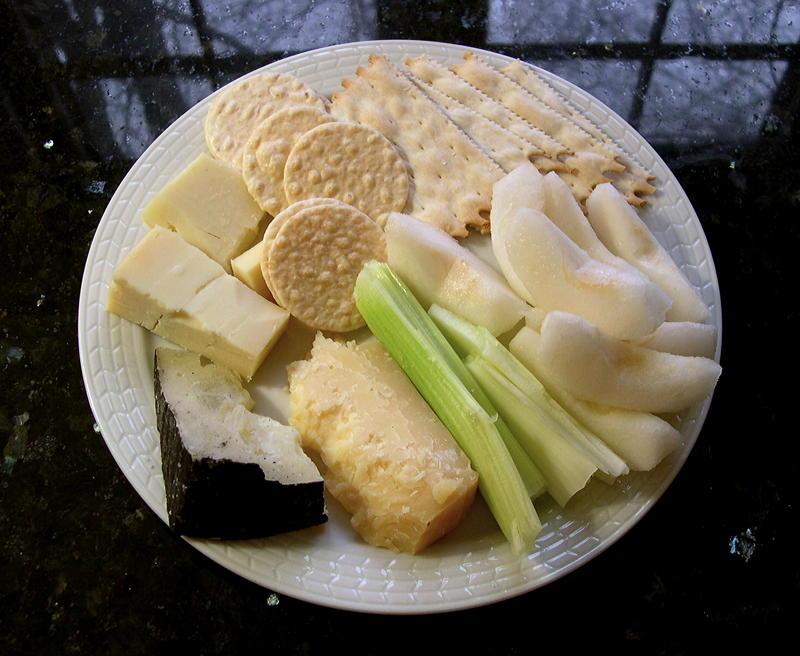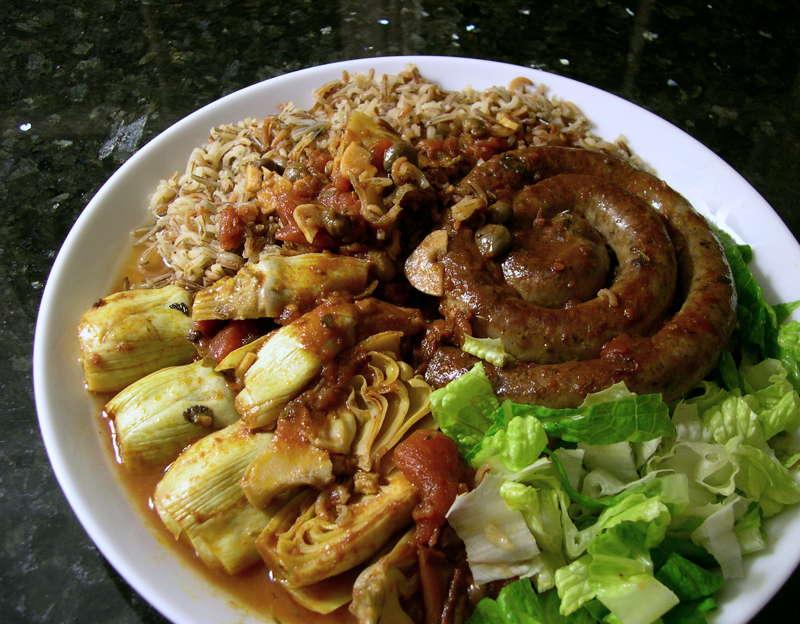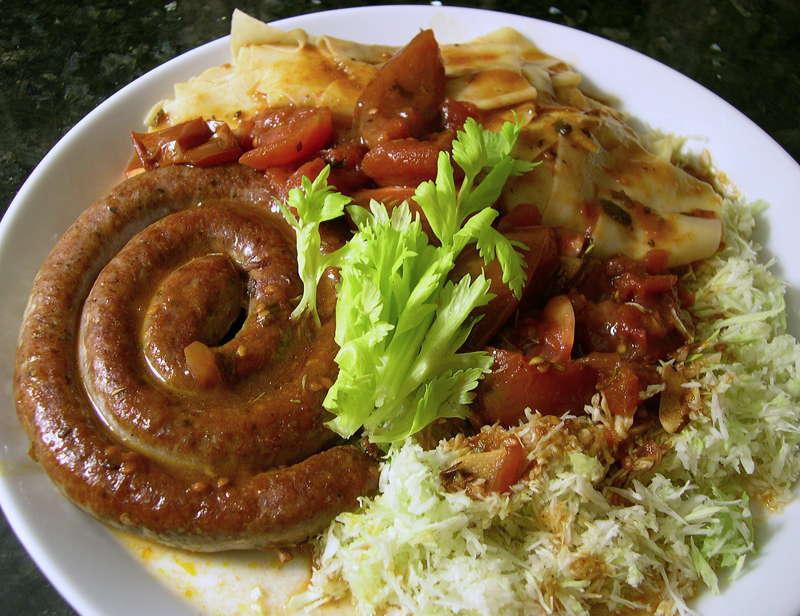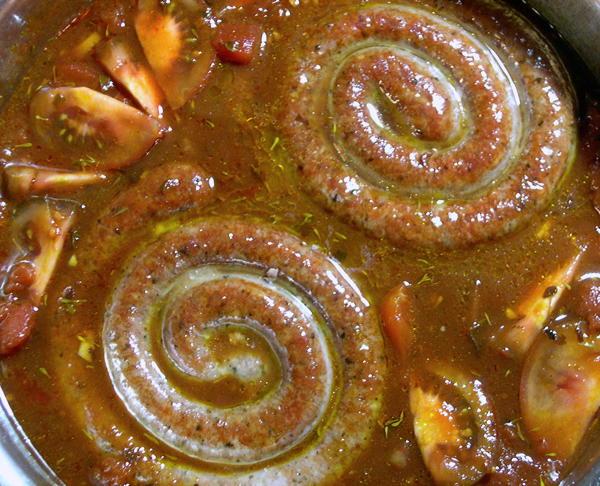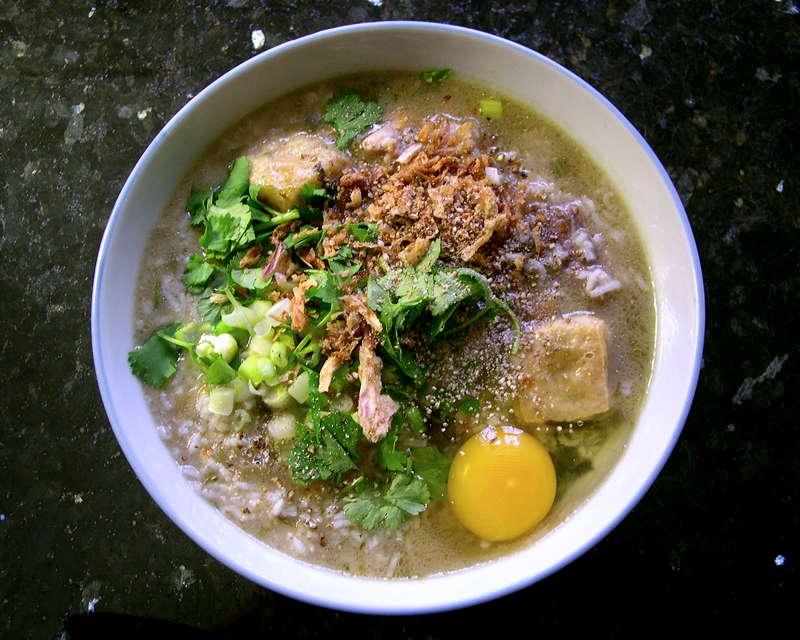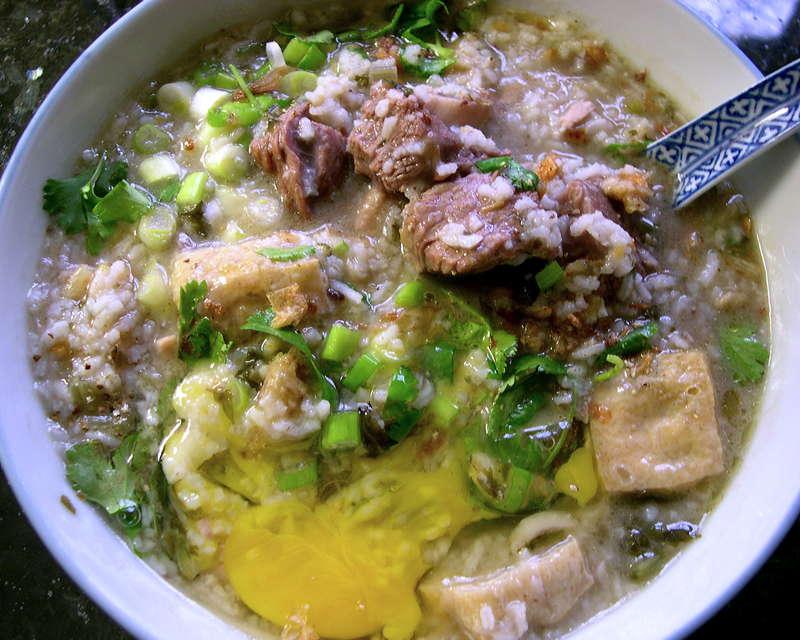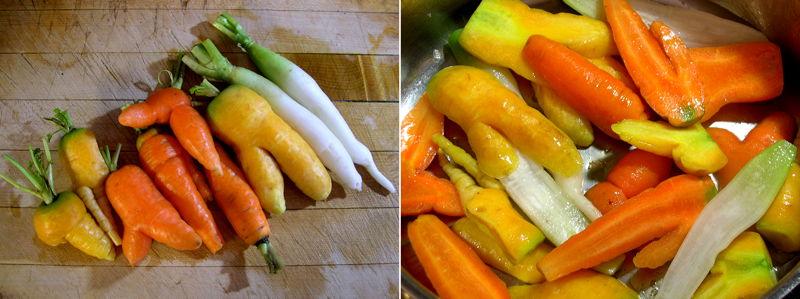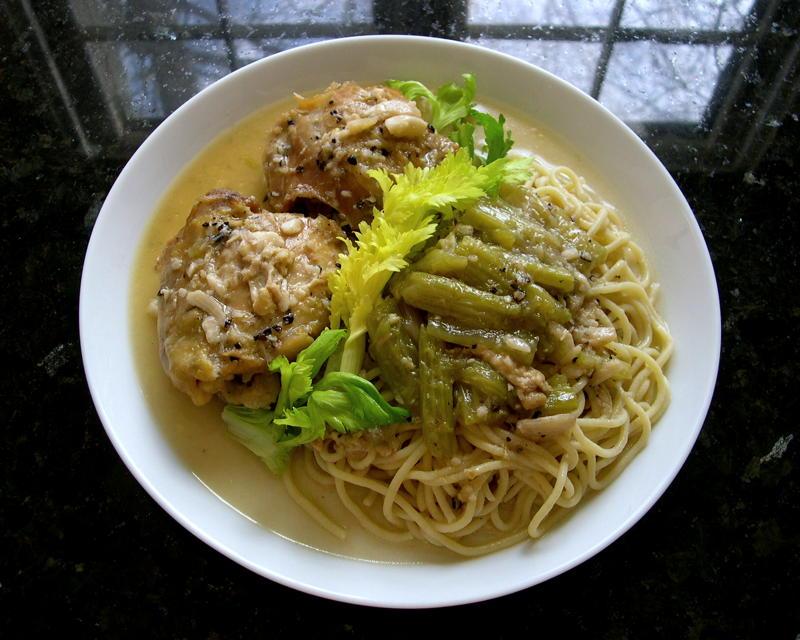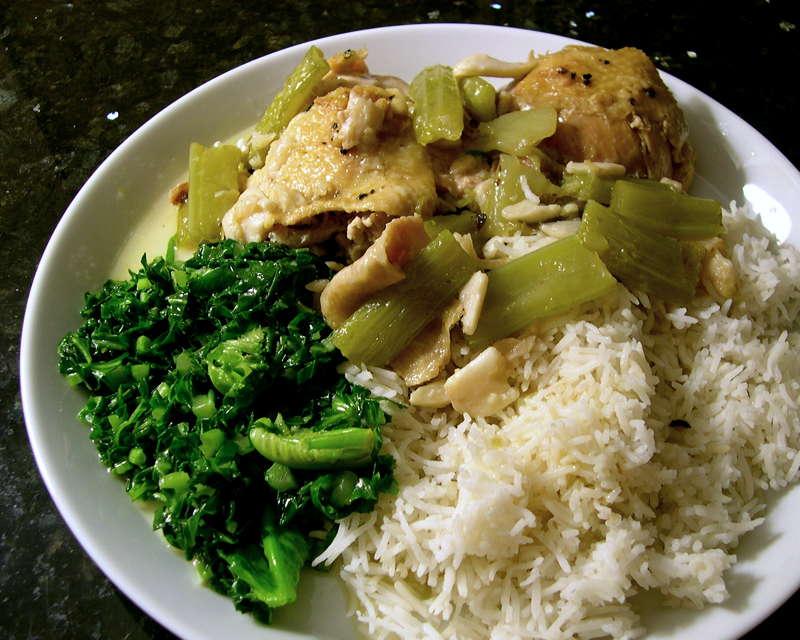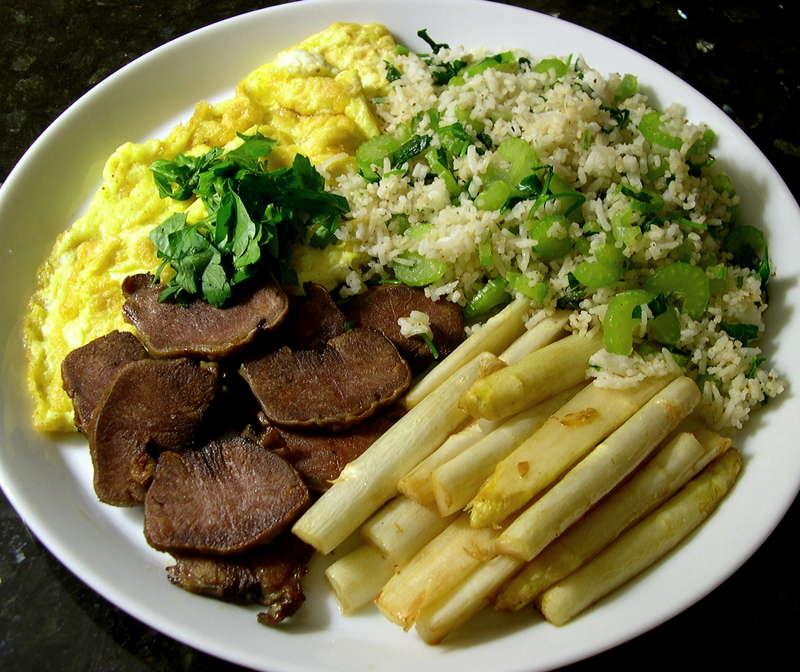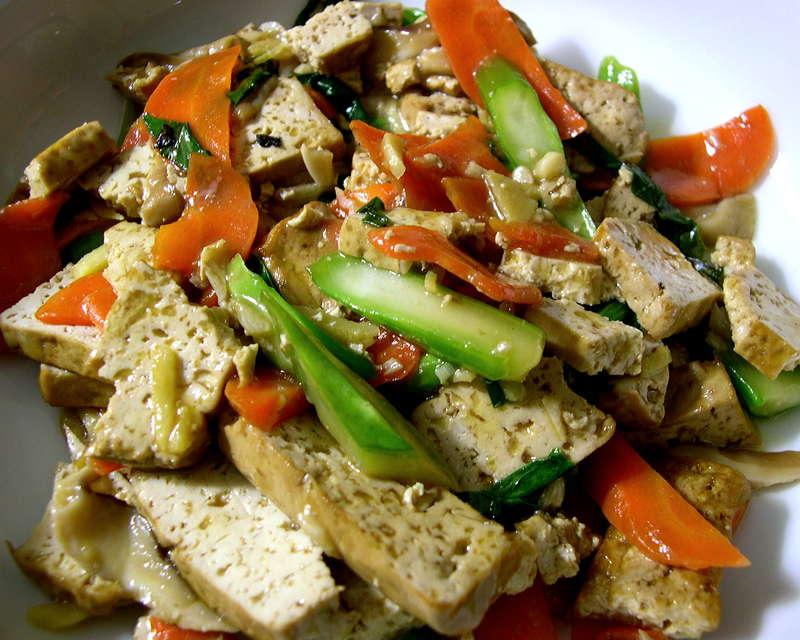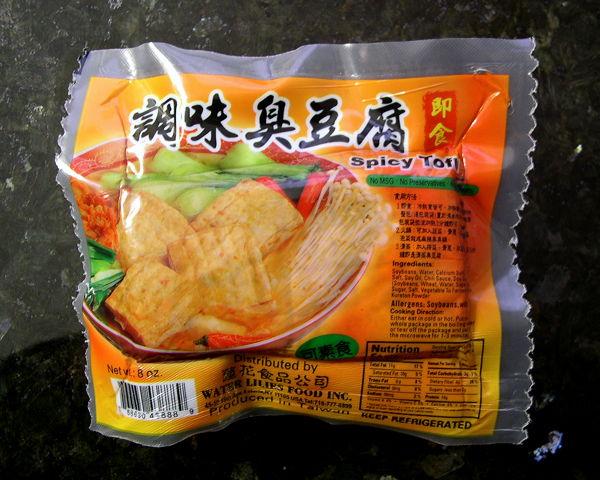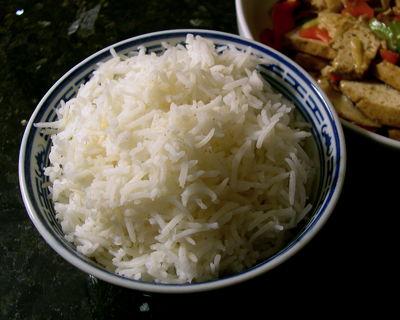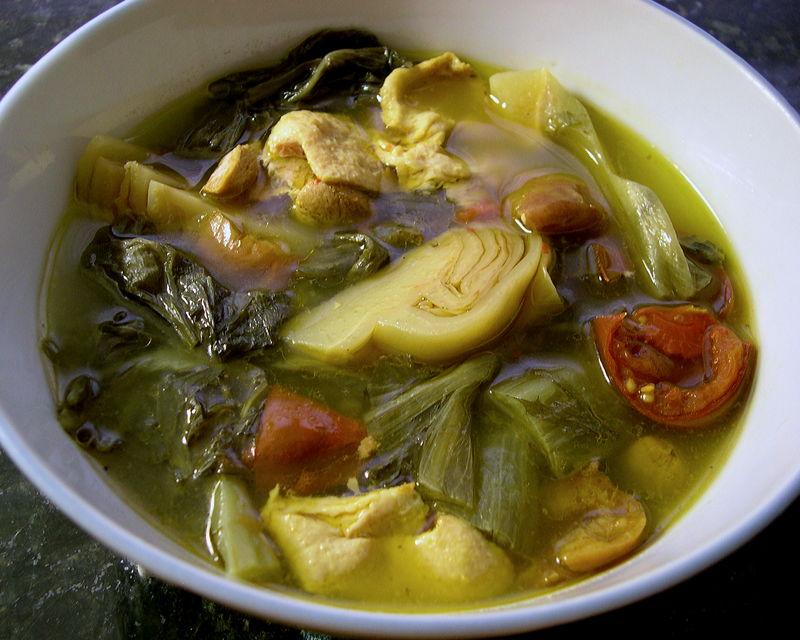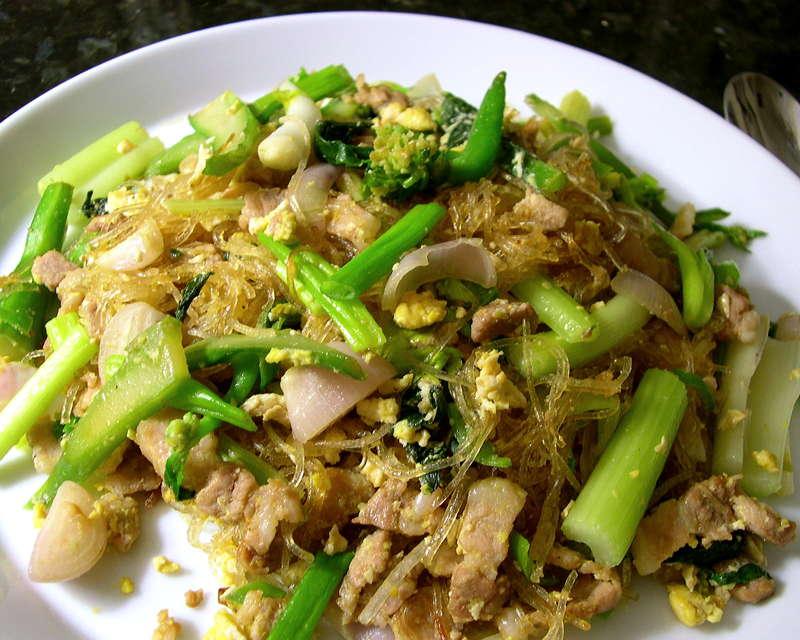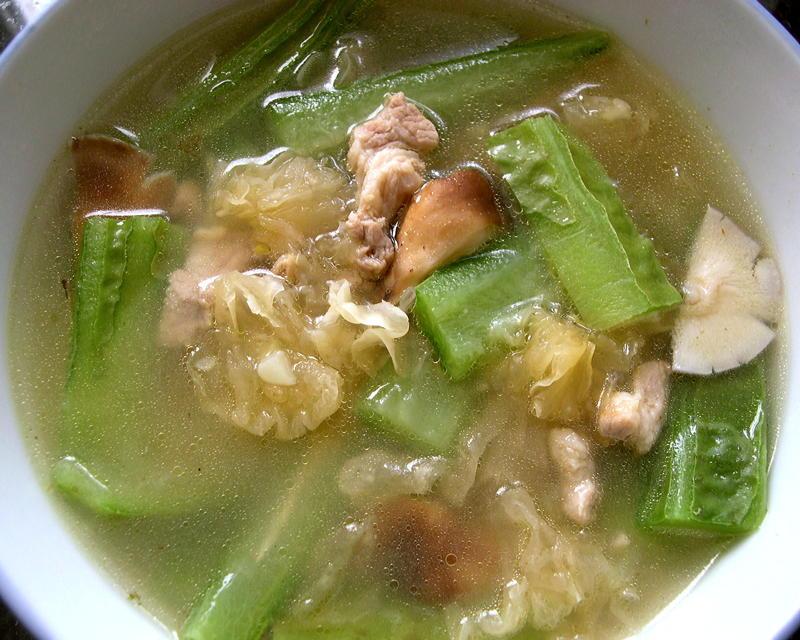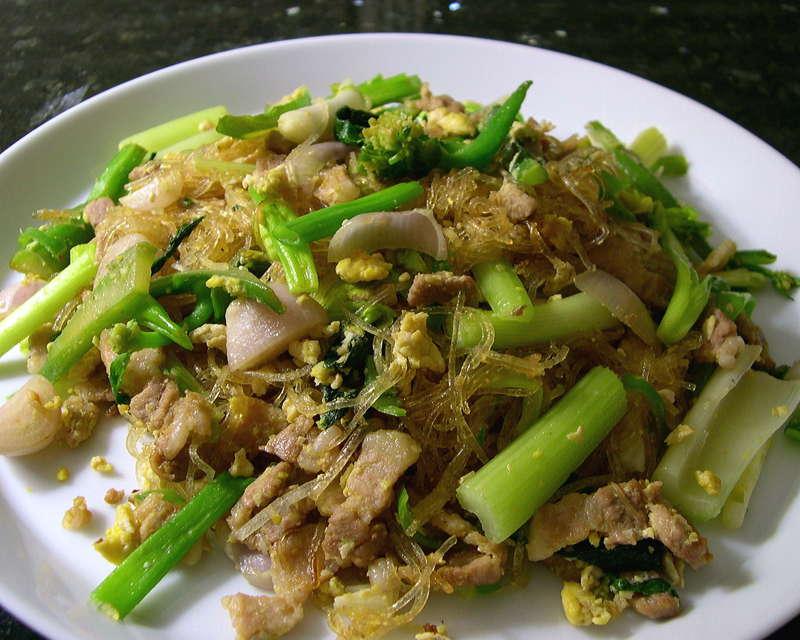-
Posts
3,810 -
Joined
-
Last visited
Content Type
Profiles
Forums
Store
Help Articles
Everything posted by huiray
-
Ann_T, thanks for the compliment. I hope you get to like steaming stuff as an additional way to cook things. :-) Your Kachin chicken curry & fried rice looks wonderful.
-
Earlier – a cheese plate. Cheeses: Vacherin Fribourgeois Alpage (the one in 3 pieces), Pecorino Ginepro (black rind), Cabot Clothbound Cheddar (Jasper Hills) (crumbly-looking one). With mini-croccantini, brown rice crackers, celery, fresh Ya Pear pieces (Pyrus x bretschneideri). Later – Schnecken Bratwurst round 2. Rest of the Schnecken in tangy tomato sauce from here, re-simmered w/ Pantelleria salted capers [Bonomo & Giglio] (briefly rinsed) & halved artichoke hearts [Reese] and seasoning adjusted. Eaten w/ wild rice [Bineshii] cooked in water salted w/ the sea salt from the capers. Plus romaine lettuce.
-
Keller responds without actually saying anything. http://ny.eater.com/2016/1/28/10858508/thomas-keller-per-se-response Some commentary, as reported by eater.com http://www.eater.com/2016/1/13/10760082/per-se-review-new-york-times-twitter
-
Schnecken Bratwurst [Claus'] in a tomato sauce. With shaved green cabbage & Cipriani Tagliardi (this one). Schnecken gently pan-fried and browned on both sides in EV olive oil on medium heat then reserved. To the pan w/ residual oil & fond: sliced garlic (Music), sauté a bit; a can of whole peeled tomatoes [Red Gold] (this one) w/ all juices,the tomatoes chopped up w/ the spatula into quarters; a half-cube of caldo de tomate con sabor de pollo [Knorr], some sea salt, some 10-year Modena balsamic vinegar [La Vecchia Dispensa] (see here), dried oregano entero, dried thyme, bay leaves, stir around, gentle sauté, a good splash of water, cover, simmer for a while. Some white balsamic vinegar [AgroDolce Bianco Delizia Estense] (this one), some turbinado sugar, a bit more sea salt; continue simmering; reserved Schnecken nestled back into the sauce, Kumato tomatoes cut into sixths added in, pan re-covered, simmered for a little while more. Tagliardi cooked as directed, drained briefly, tossed in the still-wet/warm cooking pot w/ some of the sauce from above. Served over a bed of shaved green cabbage (there's more underneath, in the picture), spooning sauce & tomatoes over the stuff. Eat. Almost there...
- 495 replies
-
- 11
-

-
Well, depends on who's doing the eating. :-) I believe some folks like chocolate-covered pretzels. Or who dip their chicken nuggets into their chocolate-topped Frosty. Folks also point out that salt+chocolate=delicious. It seems, though, that there may not be enough chocolate sauce nor enough salt on the stuff now being offered in japan to please more people than it currently does. :-) http://kotaku.com/mcdonalds-chocolate-french-fries-dont-taste-disgusting-1755137811 https://www.yahoo.com/food/we-tried-mcdonalds-chocolate-fries-in-japan-130729752.html http://www.buzzfeed.com/ryanhatesthis/we-tried-mcdonalds-new-chocolate-covered-french-fries#.ldO7lGE3b ETA: Oh, here's Brit Chris Broad approving of the chocolate fries: http://www.theguardian.com/lifeandstyle/video/2016/jan/28/mcdonalds-japans-chocolate-covered-fries-it-works-video-review :-)
-
Perhaps all you need is to up the temp of your simmering broth a few degrees. Two hours with bone-in shanks for me is sufficient to get tender, decently gelatinous meat, with a "simmer" where the bubbling is fairly pronounced but is NOT at a boil. One can also get boneless shanks a.k.a. "shins" from Chinese grocers (this is commonly found in my local Chinese/Vietnamese places, for instance). Sliced up, these cook up nicely in two hours also; in fact, going much more beyond that just makes them fall apart into bits and pieces.Usually I'd cut them up into 3/4 to 1 inch thick rounds. I've shown assorted braises with these boneless shins here and there on the dinner (and previously in the lunch) topics, stovetop-braised with stuff like daikon, or bamboo shoots, with or without miso or fermented bean curd and/or Chinese mushrooms, or carrots/potatoes/onions, & etc. (Here's a relevant search answer set with posts from others too) I wonder also if perhaps one might be expecting completely soft shank meat - some slight resistance is desirable, IMO (and what I would go for) rather than completely soft if not to the point of mushiness. Or slice the meat thinner, against the grain of course...
-
Rice congee. With beef short ribs, deboned chicken thighs & stuff. Medium-hot oil, chopped smashed garlic, julienned ginger, sauté, beef short ribs, brown/toss around. A pack of "pickled cabbage" (雪菜大王) [Da Xing brand] a.k.a. "potherb mustard" with juices added in, stirred around/sauté continued. Water. Simmer 1+ hours. Long grain rice, simmer some more. Sliced deboned chicken thigh added (the chicken bones went in earlier), simmer, halved deep fried tofu puffs (tau pok) also added in. Seasoning adjusted. A portion bowled, dressed w/ chopped scallions, coriander leaves, deep-fried shallots, ground white pepper, plus a raw farm-fresh egg. After breaking the egg, partially mixing in, and lifting up a piece of beef short rib for the pic. Total cooking time was around 2+ hours, no more than 2-and-a-half. Yes, the beef short ribs were lovely and tender.
-
Haha! Yes, that one definitely. Might not work for mortar-and-pestle stuff, though --- the SPLATTER might be a little too dramatic if one got fully into the rhythm. :-)
-
Heh. I imagine he must sing along while wrestling with his sheet metal while listening to Siegfried reforging Nothung? :-) Or all those Nibelungen hammering away. :-D I wonder if he would do the same if listening to something like Lohengrin. Oh, I wouldn't be able to do anything else when listening to opera in the opera hall, of course**...but when cooking, at home – well, it depends, as I've described. :-D (I used to be a regular annual subscriber to the Met when I lived in the greater NYC area. I miss those days. I bop up to the Chicago Lyric off-and-on nowadays.) Thinking about it more - I *can* listen to various vocal stuff when cooking, with pauses here and there - Dowland songs, for example, goes over reasonably well --- I just incorporate the rhythm and melody into my actions (like various other stuff too) - until something like "Come again, sweet love" (oh, such a cliché, I know) plays/airs, especially if done by David Daniels, say. I just have to stop cooking then. ** I remember one time, though, when I was taking in a performance of Meistersinger at the Met and looking at the simul-translations on that little console in front of me (installed at every seat) when Beckmesser was mangling his stolen-from-Walther song at the competition and almost being unable to stifle laughing out loud at the HILARIOUS translations of his "song" rendered by the Met's translator! But many of the people around me were also stifling their laughter, I realized quickly!
-
McDonald's posts sales figures globally and domestically (USA) exceeding forecasts. http://www.forbes.com/sites/laurengensler/2016/01/25/mcdonalds-fourth-quarter-earnings-all-day-breakfast/#47d0f7833850 http://www.qsrweb.com/news/mcdonalds-global-sales-increase-5-for-q4-2015/ http://www.ibtimes.com/mcdonalds-corporation-mcd-earnings-shares-soar-sales-q4-earnings-beat-wall-street-2278634 http://www.bbc.com/news/business-35401415 http://money.cnn.com/2016/01/25/investing/mcdonalds-earnings/index.html
-
I presume you mean instrumental classical. There's lots of classical music that is heavy on the lyrics - opera, lieder, songs set to stringed instruments, etc etc. For myself, I don't need music to cook with - but if I am doing something that requires "precision and careful attention" and feel like some music then almost any "popular-type" music will do with or without singers going at it because it just becomes background noise; alternatively, innocuous easy-listening-type instrumental classical. Otherwise, with both instrumental (orchestral, chamber, single instrumental - especially piano) or vocal (opera, lieder, etc) there are many pieces where I tend to stop what I'm doing and give my full attention to the music especially at certain points (some arias, various passages, etc). I can listen to these pieces if I'm cooking something that only needs intermittent attention - a long-simmering stew, for example. With some compositions I find it hard to have it on at all if I need to focus on something else. For quick/detailed/focused cooking (like multiple-ingredient stir-fries) I can't listen to these sorts of music unless I mentally "turn it off" in which case when the dish is done I'd probably replay what I had missed. There have been a few times in the past when I might be listening to a broadcast of an opera, say, and literally have to shut off the heat and take the pan off the burner while I paid attention to the part that was just coming on, with or without picking up the libretto to follow along. Otherwise, I find that just having the radio on tuned to one of the classical stations is fine for "general purposes" when I'm cooking, if I want something in the background. In a related way, when I was still working in the lab I liked to work late into the night/evenings (so would come in later in the day rather than at the crack of dawn) or on the weekends because then I could crank up the music when I was alone in the lab when I wanted to at suitable periods. One of the managers once confided to me that he could tell that I was there in the evening when he came down the corridor and heard some aria or other going at full volume the moment he turned the corner. Heh. :-) ETA: I was just idly browsing the list of still-available broadcasts on medici.tv and was reminded of one of the exceptions to the vocal-genre compositions that I can have on and still cook with attention (more or less) - Messiah (Handel) --- but I'll qualify that by saying that it should be one of the "original scale/instrumental" performances, rather than the full-scale over-orchestrated extravaganzas that some conductors in the modern age feel the piece "needs". Those I find irritating and usually shut it off (or avoid).
-
I had fun with some beautiful kinky carrots today, plus a couple icicle radishes. "Balsamic Glazed Carrots & Radishes". Oh, plus round two of the Garlic Chicken w/ Celery from before, this time on fresh spaghetti [Bettini Pasta].
-
Chicken thighs, garlic (~2 heads worth), celery, crushed black peppercorns, sea salt, water, simmer. (Chicken browned first then extra oil poured off) Sautéed collard greens. White rice.
-
TC California episode 7. I'm sorry that Jason was sent off, especially over man-bun. Glad Kwame survived, but from one's armchair his dish *looked* and sounded like the worst dish. That it tasted "good" (as shown by that snippet of Jeremy liking it) must have saved him. Jason's "underseasoning" --- eh, it DOES depend on the judges' idea of "correct seasoning", and Tom Colicchio and his crew has consistently demonstrated over the years that he and his buddies like it SALTY, SALTY. Michael Voltaggio did say that it wasn't quite there, but did not have the strong reaction that Tom C had; but I wonder if Michael V.'s taste runs towards what most professional chefs' tastes are - that is, add salt, add salt, add salt. Various chefs over the seasons have got into trouble with Tom C. & Co. for "under-seasoning" - Kelly Liken, Nicholas Elmi spring immediately to mind. There are others. Yet these last named chefs are accomplished chefs in their own right, and Nicholas Elmi for one has had success with his food at his restaurant in Philly with both critics and the dining public finding no fault with his seasoning of his food, even declaring it perfectly seasoned. One also notes that several guest judges in the past have murmured at Tom C's table that their food was just fine, while Tom C and Padma Lakshmi et al were loudly bemoaning the lack of seasoning. So in this regard man-bun HAD a point when he said to Tom C. and Michael V. that he was cooking for the judges' taste, not his own. Yes, he said it rather brashly - but he was not wrong; and IMO it is disingenuous of Tom C and Mike V to roll their eyes and pretend otherwise. What constitutes "good tasting food" depends on THEIR perception,** and that circles round again to the difference between restaurant food/professional chefs' tastes and the rest of the dining public/home cooking. BTW, I would suggest that folks do not laugh at "home cooking" - some of the best food you can get anywhere would be AT HOME, cooked by excellent cooks. ** I also remember when Richard Blais himself, now a judge, declared in one episode of one of his seasons that he needed to cook ONLY TO PLEASE THE JUDGES, and fuck the dining public even if they were eating in the place where that episode was taking place and where the food was being judged. LCK: Angelina got kicked off by Jason - good. Let's see how far Jason gets. Recaps from elsewhere: http://www.grubstreet.com/2016/01/top-chef-season-13-episode-7-recap.html http://www.ew.com/recap/top-chef-season-13-episode-7 http://www.eater.com/2016/1/22/10813566/top-chef-season-13-episode-5-the-big-ten
-
And yet "salting" and "seasoning" is very dependent on the individual. What one person finds perfectly seasoned is TOO SALTY to another. And so it goes. As for "Restaurant Food"/"Professional Chefs' Tastes" versus everyone else --- hasn't it been said that professional chefs throw salt, salt and MORE SALT into everything? That the "secret" to Restaurant Food is MORE SALT? In a related sense there has even been commentary about how many chefs/sous-chefs smoke and how that might blunt their sense of taste, and why that might contribute to their tossing mountains of salt into dishes. There are also regional differences - Mid-Western food, in my experience, is HEAVY on the salt; North-Eastern USA food much less so - and so on and so forth. A dairy-farming background, non-refrigeration background, etc etc all factor into it.
-
A combination plate. Pork tongue, white asparagus, fried rice, omelet. Eggs beaten w. some oil, white pepper, diluted w/ some water; fried in a very hot pan w/ plenty of very hot oil; lightly (Maillard) browning, folded over & removed with still runny top (now "inside"); all done in a minute or two. Braised pork tongue [Love Handle] sliced up and pan-fried after that in the residual oil. Sliced white asparagus tossed and lightly browned in the hot pan (a little more oil added) after that. Then, into the pan on full heat went chopped celery, 2-day-old rice, sea salt, chopped parsley; tossed around, covered briefly (trapping steam) at the end then stirring with the spatula in the usual manner. ETA: p.s. The pork tongue was already salted when it was braised (by Love Handle) but the only time I added salt in composing this dish was a light sprinkle in the cooking of the fried rice. Otherwise, the natural taste of the eggs, the celery+parsley+rice, the asparagus, all shone through, aided by the light browning/sort-of "light wok hei", if you would, that the hot cooking added to the food.
-
Flavored stinky tofu stir-fried with stuff. "Spicy Tofu" (that's what the English on the package says, HEH!!)** rinsed then sliced up. Hot pan, generous hot oil; stir-fry sliced ginger (goes in first), chopped smashed garlic, the sliced tofu, toss around, high heat. Add in thinly-sliced carrot, sliced kai-lan stems, fresh shiitake mushrooms cut into large slices, stir-fry; add in a mixture of soy sauce, oyster sauce in a bit of water, toss around. Thicken w/ some corn starch slurried in water. ** The stuff is actually 調味臭豆腐 which means "flavored stinky tofu". This one: I wonder about folks who pick it up expecting a "spicy tofu" - y'know, a tofu with some chili heat...- then get quite a shock when they open it up and their nostrils tell them it's not quite what they thought. :-) Mind you, the smell permeates through the packaging anyway so one would think they might get an idea of it if they paid attention... :-D Eaten voraciously with lots of rice, of course. Very tasty. Also with Teochew-style Kiam Chye Arp Teng (鹹菜鴨湯) ("salted vegetable" duck soup) (or: Kiam Chye Ark Th'ng). I used recipe P14 of "Uncle Lau's Teochew Recipes" (Epigram Books) as a jumping-off point and riffed off it. Duck legs, skin-on, most of the fat left on, cut into pieces and blanched briefly in hot water. Fresh clean water & chicken stock (I skipped the pork stock in the recipe), the duck pieces, galangal slices (not in the recipe), LOTS of fresh ground white pepper (maybe 2 Tbsp or more), wet salted/sour plums ripped apart, some of the plum pickling liquid; trimmed cut-up pickled mustard ("harm choy" a.k.a. "kiam chye")¶¶, simmer (covered). Near the end, sliced-up Kumato tomatoes, a 2-second pour of VSOP brandy; simmer for a little while more, plus extra ground white pepper. Water added once or twice during the simmering to restore the volume. Total time probably around 2 hours (not sure, didn't really keep track). ¶¶Pre-soaked for a couple hours with a couple changes of water. The stuff is the usual sour/salted mustard found ubiquitously in certain Southern Chinese/SE-Asian cuisines, available here in Chinese/SE-Asian groceries commonly in packages of individual half-plants sealed in with some of the pickling water. The vegetable used is the large-leaved mustard, "kai choy". I've shown various types of soup using this pickled mustard in many posts here on eG.
-
No, not really. I do have two books on Nyonya cooking "by my side", so to speak (amongst others), which I look at from time to time - like now. :-) A book published by the Straits Times (of Malaysia) regarding PENANG Nyonya recipes, which is skewed towards Northern Nyonya; and a book from Epigram Books (Singapore), which is more Southern Nyonya. I've posted about them elsewhere here on eG. Nevertheless, I look at internet recipes, of course, but do not have a *particular* site that I favor. Then, there are the stuff that I remember from my mother's cooking, and from other stuff in and around elsewhere.
-
Ah, I didn't think it had that much sodium in it. (I wonder what salt(s) it is in the form of...other than glutamate) (I think of konbu as having predominantly glutamic acid rather than sodium glutamate; hmm, need to check on that) Nevertheless, half a piece of konbu is all you need for a decent amount of dashi - and 90/2000 is still only a fraction of your daily allowance, and you wouldn't use all of the dashi in a single dish, unless you are making miso soup (which you can't do anyway because of the salt content of miso), or other soup-type dishes. Try Inche Kabin (Nyonya-style fried chcken), with minimal salt, maybe boosting some of the other savory spices instead. (There are no other sources of sodium in this dish). Or Khong Asam (roasted pork trotter in sour soup), which has minimal salt to start with, cut back on even that and maybe use more tamarind. I suppose if you think of the MEAT itself (the pork trotters, the chicken) as having limiting amounts of Na+ already, then these would be iffy, yes. (Tamarind pulp has very little Na+, I think)
-
Pan, you don't need the traditional ingredients for nasi ulam. Think of it as an herbed rice in the style of nasi ulam, if that helps. Use Thai basil, mint, coriander leaves, daun kesom, rau ram, etc. I think the udang kering should be enough, really, without adding more salt - maybe splash some vinegar into it the, or limau kasturi... Try this, without the extra salt, or just a tad... If you are not adding ANY further salt then that narrows the field, but as for SE Asian food REQUIRING lots of salt...eh, to each his own. :-)
-
I second this. Seconded. Or nice fleur de sel/flor de sal.
-
Just thinking out loud here, not saying I've tried every thought I murmur here... For starters...nasi ulam. Leave the udang kering in, leave out extra salt. ETA: Or even a basic nasi kerabu, leaving out the salty stuff and/or reducing the salt in the already-low-salt accompaniments...(one recipe). P.s. you can get bunga telang from Amazon even. Take a trip to Chinatown, get some really fresh shrimp (like, swimming in the tanks) and really fresh fish (again, like swimming in the tanks). Then do it Cantonese-style, simple steaming w/ ginger & scallions, maybe a splash of good (saltless) Shaohsing wine – the freshness and innate taste of the fish or shrimp may be all you need... Or pan-fry the shrimp (in shell) w/ ginger & scallions & ground pepper, very hot pan...again, the freshness and clarity and the mild seasoning should speak for itself. Or fry the fish - crispy-like --- its flavor would have its own punch. Or ikan bakar/ikan goreng w/ more turmeric & spices, skip or reduce any NaCl... Use dashi - made with good kombu/konbu - in Japanese-style cooking, using fresh ingredients; again the innate taste of the ingredients may be satisfactory without any extra NaCl. Look for Nyonya dishes where you can scale back or eliminate the NaCl but retain the punch of the seasonings with or without coconut milk. (Pure Malay dishes might be harder without a touch of salt; but since you don't need to entirely eliminate NaCl - just reduce it to less than 2 g per day - simply scaling back the amount of salt in these dishes, which often don't use that much to start with, may be all that is needed. I guess using belacan would be problematic as *that* is very salty - but a little bit goes a LONG way with this stuff...) (Think about your days in M'sia...extrapolate your observations regarding "Indian" food, in this respect, towards SE Asian food?) Yes, sure, having the salt there might make it better, but leaving it out in some kinds of dishes and looking to the innate or other flavors may be fine if not optimal for some people?
-
Pork Belly "Pad Woon Sen". A riff on "Stir-fried Glass Noodles".** Details in this post on the dinner topic. ** which is what "pad woon sen" (ผัดวุ้นเส้น) literally means, in Thai; while "glass noodles" = "cellophane noodles" = "mung bean noodles" &etc. There are, of course, similar dishes in the various related cuisines in SE and E Asia ranging all the way from Korea/Japan down all along E and SE Asia down to Indonesia. Usually the differences involve the sauces and seasonings used, sometimes the things one puts in or leaves out, and where one's initial "starting point" is. Mixtures and non-definable "which cuisine is this one from" iterations of this dish are, IMO, almost normative. :-) Like "Fried Rice". :-D
-
Hope you like it. BTW, just in case it is not apparent, the dish I made as shown is "chopstick food" with eating of the wing pieces done "E/SE Asian/Chinese style" with nibbling on it around the bones in one's mouth or while being held by the chopsticks. :-) (And the rice, as shown, being eaten w/ chopsticks in the usual manner, Chinese-style, with saucy bits etc plopped onto the rice as well) P.s. - One does not need chicken wings, as I commented on in my post. Sliced chicken pieces/chicken breast; shellfish, etc are also done this way. Less commonly w/ pork; I'm not sure if it is done w/ beef.
-
Loofah Soup. Hot oil, chopped smashed garlic, sliced pork, sea salt; water plus chicken stock, simmer; pre-soaked/rehydrated and trimmed snow fungus (Tremella fuciformis), simmer; fresh shiitake mushrooms, sliced de-ribbed angled loofah (Luffa acutangula), simmer a few minutes more. Pork Belly "Pad Woon Sen".¶¶ Medium-hot oil, sliced shallots, chopped smashed garlic, sliced-up/cut-up skinless pork belly, sauté; splash of sauce mixture,** sauté, splash of water, continue sauté; sliced kai-lan stems and inner leaves w/ leafy tops cut off, max heat, toss around; well created in center, bit more oil added, two farm-fresh eggs broken in, scrambled in situ till still slightly unset; pre-softened cellophane noodles cut-in-two across the bundles, stir & toss, rest of the sauce mixture, chopped de-seeded hot green chillies, quartered shallots, stir & toss well; trimmed de-stringed celery heart stems & leaves, trimmed scallions (lots), toss & stir & fold over. Serve. ** Sauce mixture: Fish sauce [Red Boat], double-fermented soy sauce [LKK], oyster sauce [LKK], hon-mirin [Takara], ground white pepper. ¶¶ ETA: See the asterisked note in this post for some additional comments.



